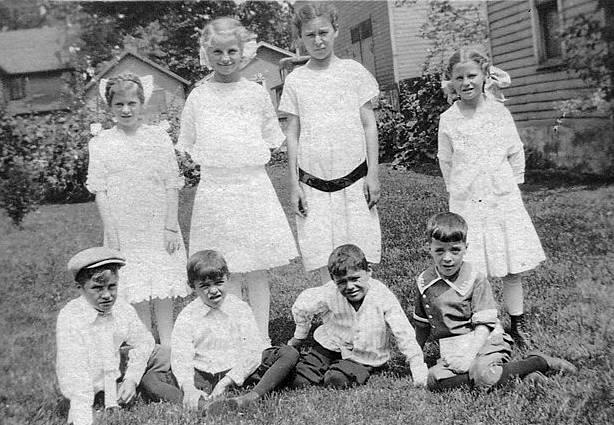
U.S. Long Stocking Gender Trends: Color Conventions--Black and White

Figure 1.--Here we see a summer backyard scene, probably about 1920. The girls wear white hair bows, white dresses, and white long stockings. The boys all wear white shirts, knickers, and black long stockings. Younger boys when dressing up might have worn white long stockings.
|
|
We can, however, see black and white stockings and identify them with a fair defree of certainty. We see a lot of white stockings when large numbers of photographic images appeared with the CDV (1860s). And the striped stockings become very commom (1870s). Black stockings became standard, but there were other dark colors and eventually light colors as well. We may make some errors, but dark colors other than black appear a little different as do light slades other than white. We suspect that the only dark shade that looks truly black would be a dark navy blue.
Black Conventions
The photographic record clearly shows that black stockings were worn by both boys and girls without any gender conventions what-so-ever. Black was not the standard when long stockings began to bcome commonly worn (1860s). They gradually became more common, especially afrr striped stockings began to go out of style (late-1870s). Black long stockings were srandard for boys and girls (1890s). We seeing them being worn for both everyday wear, school, and formality. The school here is good example (figure 1). The formal pair may be one mother kept for best or a pair of higher quality hose. Beginning in the 1920s, espcilly the mid-20s we begin to see lightervshade long stockings, grey and tan/flesh colors becomung more common. And this trend took hold, blck long stovkings bgan to be worn primrily for forml attire.
White Conventions
The photographic record also shows that white long stockings were worn by both boys and girls, but only by younger boys. White long stockings unlike black stockings were worn from an early point, basically as soon as shortened-length pants first ppeared (1850s). This probably reflects the fact that white or lighter-shade socks predominated duing the early-19th century. Black socks were not unknown, but they do not seem very common. Men wore knee breeches mostly with white stockings. And the long pants we see boys wearing seem to have most been worn with white socks as the long pants were often cut at ankle level eposing the hosiery. In the era before photography, however, paintings provide us far fewer images. As striped stockings began to disappear (late-1870s) we begom to see black and colored stockings. During the Fauntleroy era, boys including younger boys wore black long stockings. As the turn-of the 20th century approached we begin to see more and more white long stockings.
They became very common with the girls. They did not replace black stockings. We see girls of all ages very common wearing both. It was only younger boys, however, that wore white long stockings. This included both pre-school and very young primary-age boys and usually only when dressing up.
HBC

Related HBC Pages:
[Return to the main Hoisery page]
[Knee socks]
[White knee socks]
[Long stockings]
[Striped socks]
[White stockings]
[Tights]
Navigate the Historic Boys' Clothing Web Site:
[Return to the Main U.S. long stockings gender trends color page]
[Return to the Main U.S. long stockings gender trends page]
[Return to the Main U.S. long stockings page]
[Introduction]
[Activities]
[Biographies]
[Chronology]
[Clothing styles]
[Countries]
[Topics]
[Bibliographies]
[Contributions]
[FAQs]
[Glossaries]
[Links]
[Images]
[Links]
[Registration]
[Tools]
[Boys' Clothing Home]
Created: 12:19 AM 8/20/2015
Last updated: 12:44 AM 3/3/2018



